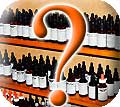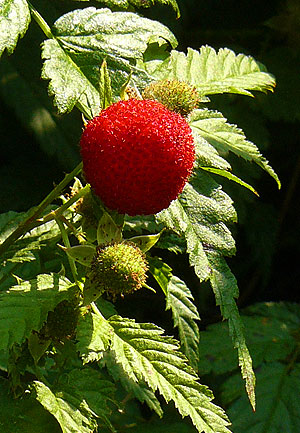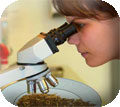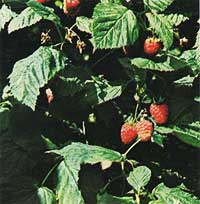|
|
  You can see more information by clicking on the tabs above

Wild Raspberries
|
aka: Mauritius raspberry, roseleaf raspberry, thimbleberry, roseleaf bramble, West Indian raspberry, ola'a
Rubus Rosifolius
Family: ROSACEAE
Wild Raspberry[1] is another "weed" which grows profusely on our land and we have heard tales of it "taking over" underutilised pasture very rapidly. The plant is listed by PIER (Pacific Island Ecosystems at Risk) as a plant species which is “threatening Pacific island ecosystems”.
However our experience is that after about 5 years in an area the plants seem to have accomplished what they came to do and they become sparse and weak, making way for other species to flourish.
We enjoy early mornings gathering their fruit for breakfast. What a delight to enjoy these natural abundant nutritional gifts from Nature.
Our Wild Raspberry is clearly related to the better-known and sweeter raspberry (Rubus idaeus) which can be found in season in fruiterers.
 The guardian angel of pregnancy and birth is a powerful cancer-buster as well
The guardian angel of pregnancy and birth is a powerful cancer-buster as well

Wild Raspberry - a great help with childbirth
and now found to be excellent for cancers
|
Wild Raspberry is outstandingly effective for
- Easing Childbirth
- Painful Menstruation
- Diarrhea
- Flu
- Morning Sickness
- As an antiinflamatory
Taken as a tea dried or fresh. The fruit is a rich source of Vitamin C.
A great help with childbirth
A friend came to our place 2 days before her baby was due and we made her up 2 large bottles of tea made from the leaves and she drank the tea often before and during her labour. With her first child she had a 16 hour labour and lots of pain during the delivery, with this one she had an hour and a half labour and experienced a drug-free relatively pain-free delivery.
Wild Raspberry is well known for making birthing easier and safer. It strengthens the uterus and entire reproductive system therefore it is great to take throughout the entire pregnancy, but especially so during the third trimester.
and with cancer too!
The University of the West Indies Department of Chemistry in Jamaica carried out research
[2] [3]
confirming that the Ursolic Acid in the fruit of the Red Raspberry (Rubus rosifolius) displayed inhibition of cancer cells in breast, lung and colon tumours and was also tested for antiinflamatory activity.
Some of the conditions we have found respond well to our Wild Raspberry tincture include:
- bedwetting
- diarrhea
- dysentery
- eye inflammations
- female applications
- hemorrhoids
- incontinence
- impotence
- infertility
- lower backache
- male disorders
|
- poor eyesight
- shingles
- skin rashes
- snake bites
- sore mouth
- stomach ailments
- strengthen gums
- throat cankers
- vaginal discharge
- wounds
|
Contra-indications:

Major medicinal actions of Wild Raspberry[4][5]

Wild Raspberry and flower
|
- antiallergic
- anticarcinogenic
- antimutagenic
- antiviral
- antivenomous
- cathartic
- emetic
- vulnerary
Wild Raspberry constituents
|
|

Major constituents of Wild Raspberry[6][7][8][9]
Red Raspberry fruit is the very best source of ellagic acid
[10] a phenolic compound known for its very potent anticarcinogenic and antimutagenic properties tested on cervical cancer, skin cancer, liver, lung and esophygus cancer with great results.

Wild Raspberry - a great help with childbirth
and now found to be excellent for cancers
|
|
|
The red raspberry leaf also contains many essential minerals such as phosphorus, potassium, and an easily assimilated form of calcium. An increased availability of calcium is necessary in controlling nerve response to pain during childbirth and in aiding bone development in the fetus. It also contains fragrine, an alkaloid which helps tone the muscles of the pelvic region including the uterus.
A study
[11] at Clemson University (CU) in South Carolina found that raspberries are a powerful weapon against cancer. Researchers said in tests, raspberry extracts successfully destroyed about 90 percent of stomach, colon, and breast cancer cells.
Raspberries are rich in powerful antioxidants, which are known to be powerful cancer fighters. But the research team from the CU Department of Nursing believe that some other substance in raspberries is also responsible for their anticancer effect.
In their study
[11] they found the extract of Red Raspberries to be 8 times more effective than Ascorbic Acid (Vitamin C) solution with more antioxidants, clearly indicating that some other substance is responsible for the destruction of cancer cells. Looks like the Ellagic acid and Ursolic acid may be the contributors.
Ursolic Acid in the fruit of the Red Raspberry (Rubus rosifolius) displayed inhibition of cancer cells in breast, lung and colon tumours
|

Wild Raspberry tea
|
Why choose a Herbal Tea?
Plants produce a vast range of substances -
phyto-chemical s - which are very beneficial in restoring and maintaining health in we humans without side-effects. We believe that they are perfectly suited to preventative and curative health care because they are natural and harmonious to our bodies.
If you do not have fresh Wild Raspberry nearby or are not confident you can identify Wild Raspberry then dried material is the next best way to obtain their beneficial influence.
How long will Wild Raspberry tea keep it's potency?
Stored properly - in an air-tight glass container away from direct sunlight - Wild Raspberry tea will keep for up to 18 months without losing it's potency. If you are dealing with the onset of a severe condition we suggest it may be worth purchasing fresh material to have complete confidence in its healing potency.
When should I drink my Tea?
For best absorption, consume herbal teas 30 minutes or more before meals or drinking other liquids to avoid diluting it while it is in your digestive tract.
Caring for your Wild Raspberry herbal tea
If you don't plan on using the tea immediately, it's best to keep it unopened and away from direct sunlight (in a closed cupboard or drawer). Exposed to the air it may absorb moisture and humidity, so if they are opened, reseal them tightly, or (preferably) put it in a glass jars with a tight-fitting lid (avoid metal containers).
Most will never require refrigeration or freezing - just keep them at average room temperature (70-80 degrees). Generally, the "shelf-life" for optimum freshness will be about a year if stored properly.
If you live in a warm, high humidity area, it may be impossible to keep moisture out of regularly opened and closed glass containers, and the plants may become mouldy. If this happens, discard them and purchase fresh ones. To prevent mould, try storing them in paper lunch bags so they can “breathe” (although this will reduce the shelf-life significantly).
Making an Infusion

pour a cup after it has infused
|
Preparing an infusion is just like making a cup of tea but allowing more time for the water to absorb the Wild Raspberry essence.
Pour boiling water over the tea (use a glass, stainless steel or ceramic vessel), cover it and allow to soak/steep for 20 minutes or so. Stirring it a few times while steeping is helpful - and is an ideal opportunity to focus your mind on the benefits it will bring to you.
Generally use 1 teaspoon of dried Wild Raspberry in a 250ml cup of water is sufficient. The standard dosage is one teacup (250ml), two or three times daily.
For convenience, your entire day's dosage can be prepared at night (2-3 cups at one time) and left overnight and then refrigerated for use throughout the day. You can drink it cold or heat it if you want it warm.
Making a Decoction
Because some tea (with bark, stems or roots in them) contains tough, woody material, a decoction is the recommended method for making your medicine.
Instead of just soaking it in hot water, the plant material is boiled for a longer period of time to soften the thicker woody pieces and release its active constituents.
Use a ceramic, glass or enamel pot with a snug fitting lid, if you don't have one then a stainless steel pot is good but definitely not aluminium or teflon.
Add the amount of herb needed (1 teaspoon per 250ml of water) to the proper amount of cold water in the pot depending on how many doses you wish to prepare.
Turn the heat to medium high and bring to a vigorous boil then put the lid on the pot and reduce the heat to maintain a gentle but cheerful simmer for 20 minutes.
If you can see steam escaping or smell the aroma of the herb, your lid is not tight enough and valuable essential oils may be escaping.
After 20 minutes, remove from heat and cool slightly, for maximum potency we encourage you to let it stand overnight.
Strain the mixture through a tea strainer into a wide-necked bottle, jug or cup, making sure to press on the material in the strainer with a spoon or similar to get as much of the liquid/decoction out of the material as possible.
Standard dosages for decoction are generally one-half to one cup, two or three times daily.
A day's dosage can be prepared the prior evening (2-3 cups at one time), allowed to continue to soak while it cools overnight to ensure maximum potency and refrigerated until ready to use throughout the next day.
Is it Safe for me to take Wild Raspberry Tincture? If you have any concerns or apprehensions please use our free Herbal Tincture enquiry service so that we can make sure that what you want is completely safe for your situation or condition.
We especially encourage you to get in touch if you have any of the following health problems or conditions:
- An enlarged prostate gland
- Are preganant or breast-feeding
- Blood clotting problems
- Cancer
- Diabetes
|
|
- Epilepsy
- Glaucoma
- Heart disease
- High blood pressure
- Immune system problems
|
|
- Liver problems
- Psychiatric problems
- Parkinson's disease
- Stroke
- Thyroid problems
|
You have two options when you purchase Wild Raspberry tincture:
- For external use which you can apply externally to the soles of your feet or topically on an external condition - you can purchase these without a consultation.
- For internal use. If you wish to take it internally because of the potency of these tinctures you need to be sure they will not cause complications with an existing health condition or prescribed drugs you may be taking.

Wild Raspberry tincture
|
If you are in any doubt about the possibility Wild Raspberry tincture causing complications with prescription drugs or a medical condition you may have please get in touch so that we can advise you on the suitability of a particular tincture.
Especially if you are pregnant or breast-feeding.
You can have an online consultation or visit our clinic for a thorough consultation if you wish to purchase our potent tinctures for internal use.
There are fewer concerns when using Wild Raspberry tincture externally and our many years of experience has shown that the tincture is just as effective being applied into the soles of the feet or applied
topically
on external conditions where they will be absorbed into your system.
Our clients who have come for a consultation use the same tincture internally and we recommend they take half an eyedropper (about 1.5ml) of herbal tincture in a small glass of water three times per day for adults and a quarter of an eyedropper in a small glass of water for children.
Wild Raspberry tincture is a potent liquid extract made from organic Wild Raspberry. It is a concentrated way of getting herbal medicine into your body easily especially applying them to the soles of your feet. Once a tincture is prepared, it has an extremely long shelf life. Tinctures should be kept in a cool, dark cupboard to maintain their potency.
If you are on any prescribed medication we strongly advise you to use our free Herbal Tincture enquiry service to make sure that the medication and potent Wild Raspberry tincture are compatible.

making medicine for internal use
|
How to Use Wild Raspberry Tincture internally
How do I prepare my Wild Raspberry Tincture?
Just add the recommended dosage - which is usually 1.5ml or one eyedropperfull - to a glass of drinking water or any other cold drink.
Then drink it.
When should I drink my Wild Raspberry Tincture?
For best absorption, consume herbal tinctures 30 minutes or more before meals or drinking other liquids to avoid diluting it while it is in your digestive tract.

How to Use our Tinctures externally

how to apply a tincture to the soles of your feet
|
If you are treating an external condition - such as a skin infection - then simply apply the tincture directly to the site using the eyedropper or a suitable swab.
If you are treating an internal condition then the best way to get the tincture into your body is through the soles of your feet. The skin is a highly absorptive organ and the feet have the reflexology facility which helps get the healing properties of the herbs right to the place inside you where they will do the most good.
If you don't have someone to do it for you, the easiest way we've found is to apply it sitting down. Rest one foot on your other leg's thigh (use a towel to make sure the tincture doesn't drip on your furniture or clothes), squirt a small amount of tincture onto the palm of one hand (about 1.5ml or half an eyedropper), rub it gently into the sole of your foot. In most cases you will find it has been absorbed within 30 seconds or so - you'll know when your foot feels dry. Then do the same to your other foot and the treatment is complete.
Wild Raspberry history
Blackberries and raspberries are native to six continents [5] and can be commonly referred to as brambles or briers. Brambles were a food and medicinal source for native peoples soon after the ice age.

the ancients respected the Wild Raspberry
|
Their benefits have been recorded by the Greeks Aeschylus, Hippocrates, Krataeus, Dioscorides, and Galen; the Romans: Cato, Ovid, and Pliny the Elder; Asian medicinal traditions, such as the Unani Tibb, traditional Chinese medicine, and the Ayurvedic tradition of India.
Medicinal uses for brambles were documented in the writings of the Ancient Greeks and Romans. Asian medicinal traditions,Traditional Chinese Medicine, and the Ayurvedic tradition of India. Folk traditions of native peoples throughout the world have also applied brambles for multiple medicinal uses.
Although in modern times these plants are grown for delicious and vitamin-rich fruit for fresh and processed product consumption, the ancients used the whole plant and its parts. Stems, branches, roots, leaves, and flowers were used in decoctions, infusions, plasters, oil or wine extractions, and condensates.
Decoctions of branches were applied to stop diarrhea, dye hair, prevent vaginal discharge, and as an anti-venom for snake bites. Leaves were chewed to strengthen gums and plastered to constrain shingles, head scurf, buldging eyes, and hemorrhoids. Flowers triturated with oil reduced eye inflammations and cooled skin rashes; infusions with water or wine aided stomach ailments.
Greeks and Romans recorded female applications, while the Chinese described uses in male disorders. The fruits of an Asian raspberry is combined in a yang tonic, called fu pen zi, “overturned fruit bowl” and prescribed for infertility, impotence, low backache, poor eyesight, and bedwetting or frequent urination.

a medieval apothecary
|
Old English books described use of brambles against dysentery combining ancient medicinal knowledge with pagan superstition and herb lore.
Medicinal properties of brambles continue in Renaissance and modern herbals, sanctioning leaf infusions as a gargle for sore mouth, throat cankers, and as a wash for wounds; the bark containing tannin, was a tonic for diarrhea; root extract a cathartic and emetic.
Recent research has measured high antioxidant content in blackberry and raspberry fruits. Fruit extracts have long been used as colorants, and are now being tested as anti-carcinogenic, anti-viral, anti-allergenic, and cosmetic moisturizing compounds.
From ancient traditions, through conventional folk medicines to the scientific confirmation of health promoting compounds, these berries are associated with health-inducing properties.

Rubus idaeus L ROSACEA
Raspberry
Like so many wild fruits the Raspberry has been known and used since pre-history in Europe, fragments of the berry being found in archaeological excavations of Swiss villages. Cultivation began in the Middle Ages, and the many European raspberry cultivars are all developed from this wild species. Prior to 1866 (at which time over 4I varieties were known in the United States of America) all American types were also from R. idaeus. They are now also developed from R. ulmifolius Schott, R. ursinus Cham and Schlechtend, R, occidentalis L. Rubus is from the Latin for red, and idaeus means 'of Mount lea', after its abundance on Mount lda.
Description Upright or bent perennial 90-I50 cm tall, with varying degrees of prickles or sometimes entirely lacking them. Leaves: glabrous above, grey tomentose beneath, comprising 3 or 5 ovate leaflets. Flowers small, 1 -6 in drooping panicles in terminal axils, appearing early to mid-summer, followed by aromatic fleshy cone-shaped red to yellow fruit.
Distribution Eurasian native, introduced and widespread. In woodland clearings and edges, especially deciduous woodlands. On light soil, moist and rich in nutrients, to 2000 m in altitude.
Cultivation Wild. Numerous cultivars propagated by suckers or root cuttings. Canes should be removed after fruiting to allow new ones (primocanes) to develop. Tolerates most soils.
Constituents (leaves) Fragarine and other substances, acting in isolation as both uterine muscle stimulants and relaxants. (fruit) Citric acid; vitamin C; pectin.
Uses (fresh or dried leaves, fruit) Astringent; oxytocie; nutritive; laxative. The leaf is of proven value during confinement, if taken regularly and in small doses as an infusion - it eases and speeds parturition. In larger doses the leaf is of benefit in painful menstruation and also in diarrhoea. In large amounts the fruit is mildly laxative. The fruit was formerly employed in a variety of pharmaceutical and herbal products as a flavouring and colouring. Edible fruit is of economic importance.
Used in wines, liqueurs, vinegars, syrups, and for other confectionery, culinary and some cosmetic purposes. |
Wild Raspberry cultivation

a young Wild Raspberry sucker
|
Generally acknowledged as a weed [12][13][14][15][16][17] which prefers the less temperate climates, Wild Raspberry is easy to grow from root divisions and seed.
Cultivation details [6]
Easily grown in a good well-drained loamy soil in sun or semi-shade. Not very hardy outdoors in Britain, it usually requires greenhouse protection. This species is a raspberry with biennial stems, it produces a number of new stems each year from the perennial rootstock, these stems fruit in their second year and then die. The fruit is sold in local markets in the Himalayas. Plants in this genus are notably susceptible to honey fungus.
Propagation
Seed - requires stratification and is best sown in early autumn in a cold frame. Stored seed requires one month stratification at about 3°C and is best sown as early as possible in the year. Prick out the seedlings when they are large enough to handle and grow on in a cold frame. Plant them out into their permanent positions in late spring of the following year. Cuttings of half-ripe wood, July/August in a frame. Tip layering in July. Plant out in autumn. Division in early spring or just before leaf-fall in the autumn.
Wild Raspberry video footage
|
|
Some video showing you Wild Raspberry courtesy Dancing Spectrum Video
| Some video showing you Wild Raspberry |
  You can see more information by clicking on the tabs below
middlepath.com.au> Middle Path> Plants> Wild Raspberry Rubus RosifoliusReferences| [#] | Source | Title and link to resource if available | | [1] | Wikipedia | Rubus rosifolius |
| [2] | ScienceDirect | Ursolic acid analogues: non-phenolic functional food components in Jamaican raspberry fruits |
| [3] | Journal of Food Composition and Analysis; V23, I6, Sep2010, Pp 554�560 | Anthocyanin content, antioxidant, anti-inflammatory and anticancer properties of blackberry and raspberry fruits |
| [4] | Current Medicinal Chemistry, V11, N11, Jun2004, pp1501-1512 | Therapeutic Constituents and Actions of Rubus Species |
| [5] | USDA - ARS | Rubus pharmacology: antiquity to the present |
| [6] | Plant for the Future database | Rubus rosifolius |
| [7] | PlantNET | Rubus rosifolius |
| [8] | Tim Low | Bush Medicine - A Pharmacopoeia of Natural Remedies (ISBN 0-207-16462-2) |
| [9] | I.Southwell, Australian Journal of Chemistry 1978 | The Constituents of Rubus rosifolius. The Structure of Rosifoliol, a Biogenetically Significant Sesquiterpenoid (ISBN unknown) |
| [10] | Nutrition Health Review | Ellagic acid in red raspberries found to prevent cancer |
| [11] | naturalnews.com | Discover the cancer-fighting power of raspberries |
| [12] | Pacific Island Ecosystems at Risk (PIER) | Rubus rosifolius |
| [13] | Global Compendium of Weeds | Rubus rosifolius |
| [14] | Plants Database, United States Department of Agriculture | Rubus rosifolius |
| [15] | Encyclopedia of Life | Rubus rosifolius Mauritius Raspberry |
| [16] | Encyclopedia of Life | Rubus rosifolius West Indian Raspberry |
| [17] | BioNET-EAFRINET | Rubus rosifolius (Rose-leaf Bramble) |
|
|
















